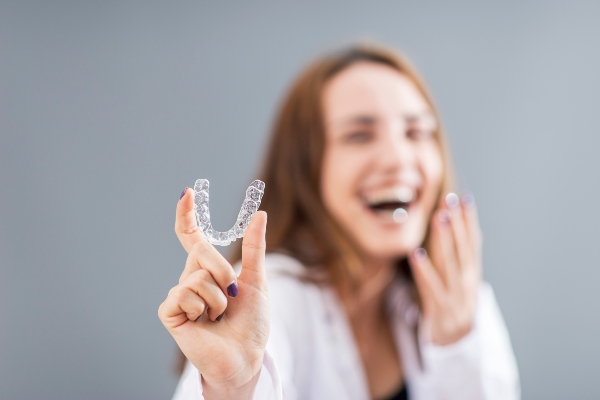Why Skipping Your Retainer Can Undo Years of Orthodontic Work

Retainers are a proven way to maintain the results after orthodontic treatment. They hold the teeth in place to prevent them from shifting around, solidifying the results of braces, aligners, or other teeth straightening treatments. By skipping retainers, the teeth will shift back out of place. Understanding the importance of retainers can motivate patients to wear them consistently and prevent undoing years of orthodontic work.
Why do you have to wear retainers?
Orthodontic treatment can gradually shift the teeth into the proper positions to create a more even, aligned smile. However, the teeth do not stop shifting once they reach proper alignment. They will likely shift back out of alignment without a retainer to hold them in place. The teeth will need to get used to their new positions before they can stay in place on their own.
This is where retainers come in. Retainers help ensure the teeth remain in their correct position during this adjustment period. Orthodontists prescribe removable or fixed retainers during the post-treatment phase. The patient may need to use both at the same time. However, most patients benefit from wearing only removable retainers almost all day before slowly decreasing their use until they no longer need them.
Why the teeth shift after orthodontic treatment
The memory of the surrounding tissues causes the teeth to naturally shift after orthodontic work. Even though the orthodontist has repositioned the teeth, the tissues, gums, and ligaments that hold the teeth in place take time to adapt to their new alignment. Further, the muscles and jawbone structure surrounding the teeth exert pressure, returning teeth to where they were before. Everyday habits such as chewing, swallowing, and teeth grinding can also cause teeth to shift without consistent retainer use. Thus, some patients wear their retainers every now and then long after the recommended timeframe to combat this and maintain results.
Signs that skipping your retainer is affecting your smile
Skipping retainer use can negatively affect the patient's smile. This is particularly the case when patients skip using retainers soon after orthodontic work or stop using them before the timeframe recommended by the orthodontist.
The first sign that skipping retainer use has already started to affect the patient's smile is when they have difficulty fitting into a retainer that once fit perfectly. The retainer will likely feel tight as it shifts minorly strayed teeth back into proper alignment. Tightness that lasts longer than a few minutes and causes prolonged discomfort is a sign that the teeth have shifted significantly. As long as the retainer can still fit in the mouth, the teeth should go back into place. The discomfort should subside with consistent retainer use.
However, a retainer that no longer fits at all is a sign that the teeth have shifted beyond the retainer's capabilities. The same is true if the smile has changed noticeably to the naked eye, such as if there are gaps or crowding. The patient would need to consult an orthodontist on how to get their teeth back into proper alignment. After this, retainer use would be recommended again.
How to incorporate removable retainers into your daily routine
It is common for patients to skip days or nights of wearing removable retainers without intending to, especially if they have a fixed orthodontic treatment like braces. Making a habit of wearing retainers can help a patient adapt to using them consistently. Fortunately, most patients must wear retainers for most of the day during the first few months. Here are a few tips to help follow this recommendation:
- Only take retainers out to eat, drink hot liquids, or brush the teeth
- Always put retainers in the provided case when removed
- Get retainers fixed or replaced promptly if broken or lost
When it comes time to reduce retainer use, patients may want to start by wearing them mostly in the morning and afternoon. They can then take them off at dinner and put them back in for sleep. It is always easier to remember to take off retainers, whereas remembering to put them on can easily slip one's mind. Eventually, patients can start to wear their retainers only in the morning and to sleep. The end goal is either to wear them only while sleeping or not at all, depending on the orthodontist's recommendations.
Get more information from an orthodontist
Skipping retainers can undo orthodontic work because the teeth will shift back out of place. To learn more about retainers and what to expect, talk to our Reston orthodontist. Simply call Precision Orthodontics & Pediatric Dentistry for an appointment today.
Request an appointment here: https://www.orthodonticprecision.com or call Precision Orthodontics & Pediatric Dentistry at (703) 391-8800 for an appointment in our Reston office.
Check out what others are saying about our services on Yelp: Read our Yelp reviews.
Recent Posts
Invisalign® is a system of transparent aligners that are custom-made to fit a person's teeth. Like braces, it corrects alignment by delivering different levels of pressure to individual teeth. Since everyone has a unique smile, you will need a custom-made pair of Invisalign clear aligners. This article provides information on how clear aligners are custom-made…
Invisalign® aligners are a popular alternative to conventional metal braces. Although Invisalign offers more comfort than metal braces, it is impossible to eliminate the chances of mild pain or discomfort. The risk of discomfort seems to be highest during the first week of wearing invisible teeth aligners.A person’s pain tolerance also determines the degree of…
Thinking about getting Invisalign®? Read on to learn some of the benefits of choosing this teeth-straightening treatment. Most people want a beautiful smile, but many people do not want to undergo teeth-straightening treatments that involve conspicuous metal braces. Fortunately, another option called Invisalign involves wearing transparent aligner trays over time to correct tooth misalignment. A…
If you are considering Invisalign® treatment for teeth straightening, you will likely want details about the process. Read on to learn about what happens during and after Invisalign treatment. When you visit the orthodontist for a consultation, they will explain the specifics of what to anticipate during and after treatment. They will also discuss using…


